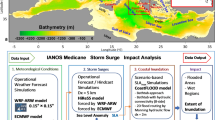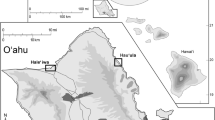Abstract
Meteotsunamis (localized ocean waves with periods similar to those of tsunamis but caused by meteorological phenomena) have been observed around the globe and are frequently observed in the Adriatic Sea. Numerous studies have focused on numerical modeling of meteotsunamis, but only a few have modeled flooding and drying of the coastal areas that play an important role in risk assessment. In this study, we model four historic meteotsunami events (Vela Luka Bay, June 21, 1978; Široka Bay, August 22, 2007; Mali Lošinj Bay August 15, 2008; Stari Grad Bay February 19, 2010) that occurred in the Adriatic Sea, using ADICRC, a flooding and drying capable ocean numerical model. Comparison of those results with similar simulations that do not use the flooding and drying algorithm was made to determine differences in modeled wave height. Three of the modeled events (Vela Luka, Široka and Mali Lošinj) are more accurately depicted if including the flooding and drying algorithm, suggesting that extreme events can be more realistically modeled than with the more commonly used cut-off depth (i.e., specifying minimum depth larger than expected maximum wave height). Modeling results for the fourth event (Stari Grad) confirm a previous assumption that flooding occurred due to the superposition of a storm surge and a meteotsunami, rather than a meteotsunami alone.













Similar content being viewed by others
References
Belušić D, Strelec Mahović N (2009) Detecting and following atmospheric disturbances with a potential to generate meteotsunamis in the Adriatic. Phys Chem Earth 34:918–927
Bubalo M, Janeković I, Orlić M (2019) Simulation of flooding and drying as an essential element of meteotsunami modelling. Cont Shelf Res 184:81–90. https://doi.org/10.1016/j.csr.2019.07.003
Chen Y, Niu X (2018) Forced wave induced by an atmospheric pressure disturbance moving towards shore. Cont Shelf Res. 160:1–9. https://doi.org/10.1016/j.csr.2018.03.007
Cyriac R, Dietrich JC, Fleming JG, Blanton BO, Kaiser C, Dawson CN, Luettich RA (2018) Variability in coastal flooding predictions due to forecast errors during Hurricane Arthur. Coast Eng J 137:59–78. https://doi.org/10.1016/j.coastaleng.2018.02.008
Denamiel C, Šepić J, Vilibić I (2018) Impact of geomorphological changes to harbor resonance during meteotsunamis: the Vela Luka Bay test case. Pure Appl Geophys 175:3839–3859. https://doi.org/10.1007/s00024-018-1862-5
Dietrich JC, Kolar RL, Luettich RA (2004) Assessment of ADCIRC’s wetting and drying algorithm. Dev Water Sci 55:1767–1778
Ewing M, Press F, Donn WL (1954) An explanation of the Lake Michigan wave of 26 June 1954. Science 120:684–686
Green G (1838) On the motion of waves in a variable canal of small depth and width. Transactions of the Cambridge Philosophical Soc 6:457–462
Hagen SC, Bacopoulos P, Cox AT, Cardone VJ (2011) Hydrodynamics of the 2004 Florida hurricanes. J Coast Res. https://doi.org/10.2112/JCOASTRES-D-10-00170.1
Hibiya T, Kajiura K (1982) Origin of ‘abiki’ phenomenon (kind of seiches) in Nagasaki Bay. J Oceanogr Soc Japan 38:172–182
Hill DF, Griffiths SD, Peltier WR, Horton BP, Törnqvist TE (2011) High-resolution numerical modelling of tides in the western Atlantic, Gulf of Mexico, and Caribbean Sea during the Holocene. J Geophys Res Oceans 116:C10014. https://doi.org/10.1029/2010JC006896
Jones JE, Hall P, Davies AM (2009) An inter-comparison of tidal solutions computed with a range of unstructured grid models of the Irish and Celtic Sea regions. Ocean Dyn 59:997–1023. https://doi.org/10.1007/s10236-009-0225-2
Ličer M, Mourre B, Troupin C, Krietemeyer A, Jansá A, Tintoré J (2017) Numerical study of Balearic meteotsunami generation and propagation under synthetic gravity wave forcing. Ocean Model 111:38–45
Linares Á, Wu CH, Anderson EJ, Chu PY (2018) Role of meteorologically induced water level oscillations on bottom shear stress in freshwater estuaries in the Great Lakes. J Geophys Res 123:4970–4987. https://doi.org/10.1029/2017JC013741
Lončar G, Carević D, Paladin M (2010) The (im)possibility of reducing the meteotsunami amplitude by constructing protective breakwaters. Tech Gaz 17:217–222
Luettich RA, Westerink JJ (1995) An assessment of flooding and drying techniques for use in the ADCIRC hydrodynamic model: implementation and performance in one-dimensional flows. Technical Report.
Lynch DR, Gray WG (1979) A wave equation model for finite element tidal computations. Comput Fluids 7:207–2284
Monserrat S, Vilibić I, Rabinovich AB (2006) Meteotsunamis: atmospherically induced destructive ocean waves in the tsunami frequency band. Nat. Hazards Earth Syst. Sci. 6:1035–1051. https://doi.org/10.5194/nhess-6-1035-2006S
Orlić M (1980) About a possible occurrence of the Proudman resonance in the Adriatic. Thalassia Jugosl 16:79–88
Orlić M, Belušić D, Janeković I, Pasarić M (2010) Fresh evidence relating the great Adriatic surge of June 21 1978 to mesoscale atmospheric forcing. J Geophys Res 115:C06011
Orlić M (2015) The first attempt at cataloguing tsunami-like waves of meteorological origin in Croatian coastal waters. Acta Adriat 56:83–96
Pasarić M, Orlić M (2007) Eigenfrequencies of Vela Luka and Stari grad Bays (east Adriatic). Rapp Comm int Mer Médit 38:120
Rabinovich AB (2019) Twenty-seven years of progress in the science of meteorological tsunamis following the 1992 Dayton Beach event. Geophys, Pure Appl. https://doi.org/10.1007/s00024-019-02349-3
Synolakis CE (1991) Tsunami runup on steep slopes: how good linear theory really is. Nat Hazards 4:221–234
Šepić J, Vilibić I, Belušić D (2009) Source of the 2007 Ist meteotsunami (Adriatic Sea). J Geophys Res 114:C03016
Šepić J, Vilibić I (2011) The development and implementation of a real-time meteotsunami warning network for the Adriatic Sea. Nat Hazards Earth Syst Sci 11:83–91
Šepić J, Vilibić I, Fine I (2015) Northern Adriatic meteorological tsunamis: assessment of their potential through numerical modeling experiments. J Geophys Res 120:2993–3010
Thomas A, Dietrich JC, Asher TG, Bell M, Blanton BO, Copeland JH, Cox AT, Dawson CN, Fleming JG, Luettich RA (2019) Influence of storm timing and forward speed on tides and storm surge during Hurricane Matthew. Ocean Model 137:1–19. https://doi.org/10.1016/j.ocemod.2019.03.004
Thomson RE, Rabinovich AB, Fine IV, Sinnot DC, McCarthy A, Sutherland NAS, Neil LK (2009) Meteorological tsunamis on the coasts of British Columbia and Washington. Phys Chem Earth 34:971–988
Tintoré J, Gomis D, Alonso S, Wand DP (1988) A theoretical study of large sea level oscillations in the Western Mediterranean. J Geophys Res 93:10797–10803
Vilibić I, Domijan N, Orlić M, Leder N, Pasarić M (2004) Resonant coupling of a travelling air pressure disturbance with the east Adriatic coastal waters. J Geophys Res 108:C10001
Vilibić I (2005) Numerical study of the Middle Adriatic coastal waters’ sensitivity to the various air pressure travelling disturbances. Ann Geophys 23:3569–3578
Vilibić I, Šepić J, Pasarić M, Orlić M (2017) The Adriatic Sea: a long-standing laboratory for sea level studies. Pure Appl Geophys 174:3765–3811. https://doi.org/10.1007/s00024-017-1625-8
Westerink JJ, Blain CA, Luettich RA, Scheffner NW (1994) ADCIRC: an advanced three-dimensional circulation model for shelves coasts and estuaries. Coastal Engineering Research Center, Vicksburg, Mississippi Report 2: User’s manual for ADCIRC-2DDI, Dredging Research Program Technical Report DRP-92–6.
Acknowledgments
The authors would like to thank the Croatian National Weather Service for providing barograms for August 15, 2008, and the Hydrographic Institute of the Republic of Croatia for providing Split and Dubrovnik tide gauge records for February 18–20, 2010.
Funding
The study was conceived and started within the framework of the project 2831 Climate of the Adriatic REgion in its global context (CARE) and completed within the framework of the project 9849 Middle Adriatic Upwelling and Downwelling (MAUD), both fully funded by the Croatian Science Foundation.
Author information
Authors and Affiliations
Corresponding author
Ethics declarations
Conflict of interest
The authors have no conflicts of interest to declare that are relevant to the content of this article.
Additional information
Publisher's Note
Springer Nature remains neutral with regard to jurisdictional claims in published maps and institutional affiliations.
Rights and permissions
About this article
Cite this article
Bubalo, M., Janeković, I. & Orlić, M. Meteotsunami-related flooding and drying: numerical modeling of four Adriatic events. Nat Hazards 106, 1365–1382 (2021). https://doi.org/10.1007/s11069-020-04444-4
Received:
Accepted:
Published:
Issue Date:
DOI: https://doi.org/10.1007/s11069-020-04444-4




